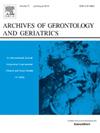Exploring the association between aging, ferroptosis, and common age-related diseases
IF 3.5
3区 医学
Q2 GERIATRICS & GERONTOLOGY
引用次数: 0
Abstract
Aging is a natural biological process that is characterized by the progressive decline in physiological functions and an increased vulnerability to age-related diseases. The aging process is driven by different cell and molecular mechanisms. It has recently been shown that aging is associated with heightened vulnerability to ferroptosis (an intracellular iron-dependent form of programmed cell death). This susceptibility arises from various factors including oxidative stress, impaired antioxidant defences, and dysregulated iron homeostasis. The progressive decline in cellular antioxidant capacity and the accumulation of damaged components contribute to the increased susceptibility of aging cells to ferroptosis. Dysregulation of key regulators involved in ferroptosis, such as glutathione peroxidase 4 (GPX4), iron regulatory proteins, and lipid metabolism enzymes, further exacerbates this vulnerability. The decline in cellular defence mechanisms against ferroptosis during aging contributes to the accumulation of damaged cells and tissues, ultimately resulting in the manifestation of age-related diseases. Understanding the intricate relevance between aging and ferroptosis holds significant potential for developing strategies to counteract the detrimental effects of aging and age-related diseases. This will subsequently act to mitigate the negative consequences of aging and improving overall health in the elderly population. This review aims to clarify the relationship between aging and ferroptosis, and explores the underlying mechanisms and implications for age-related disorders, including neurodegenerative, cardiovascular, and neoplastic diseases. We also discuss the accumulating evidence suggesting that the imbalance of redox homeostasis and perturbations in iron metabolism contribute to the age-associated vulnerability to ferroptosis.
探讨衰老、铁下垂和常见年龄相关疾病之间的关系
衰老是一种自然的生物过程,其特征是生理功能的逐渐衰退和对年龄相关疾病的易感性增加。衰老过程是由不同的细胞和分子机制驱动的。最近有研究表明,衰老与铁凋亡(一种细胞内依赖铁的程序性细胞死亡形式)的易感性增加有关。这种易感性是由多种因素引起的,包括氧化应激、抗氧化防御受损和铁稳态失调。细胞抗氧化能力的逐渐下降和受损成分的积累导致衰老细胞对铁下垂的易感性增加。参与铁死亡的关键调节因子,如谷胱甘肽过氧化物酶4 (GPX4)、铁调节蛋白和脂质代谢酶的失调,进一步加剧了这种易感性。衰老过程中抗铁下垂的细胞防御机制的下降导致受损细胞和组织的积累,最终导致与年龄有关的疾病的表现。了解衰老和铁下垂之间的复杂关联,对于制定对抗衰老和年龄相关疾病的有害影响的策略具有重要的潜力。这将随后减轻老龄化的负面影响,并改善老年人口的整体健康状况。本文旨在阐明衰老与铁下垂之间的关系,并探讨其潜在机制及其对年龄相关疾病的影响,包括神经退行性疾病、心血管疾病和肿瘤疾病。我们还讨论了越来越多的证据表明,氧化还原稳态的不平衡和铁代谢的扰动有助于年龄相关的铁中毒易感性。
本文章由计算机程序翻译,如有差异,请以英文原文为准。
求助全文
约1分钟内获得全文
求助全文
来源期刊
CiteScore
7.30
自引率
5.00%
发文量
198
审稿时长
16 days
期刊介绍:
Archives of Gerontology and Geriatrics provides a medium for the publication of papers from the fields of experimental gerontology and clinical and social geriatrics. The principal aim of the journal is to facilitate the exchange of information between specialists in these three fields of gerontological research. Experimental papers dealing with the basic mechanisms of aging at molecular, cellular, tissue or organ levels will be published.
Clinical papers will be accepted if they provide sufficiently new information or are of fundamental importance for the knowledge of human aging. Purely descriptive clinical papers will be accepted only if the results permit further interpretation. Papers dealing with anti-aging pharmacological preparations in humans are welcome. Papers on the social aspects of geriatrics will be accepted if they are of general interest regarding the epidemiology of aging and the efficiency and working methods of the social organizations for the health care of the elderly.

 求助内容:
求助内容: 应助结果提醒方式:
应助结果提醒方式:


